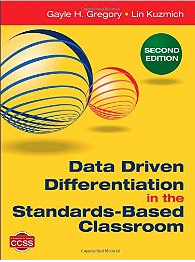I have just read “Data Driven Differentiation in the Standards-Based Classroom” by Gayle H. Gregory and Lin Kuzmich. Because the reality of teaching has shifted dramatically from a decade ago, this book is a must for new, experienced and preservice teachers as well as anyone who observes teaching in the classroom, evaluates teaching, or coaches teachers.

Applying the research-based strategies from the likes of Marzano and Reeves, and integrating these strategies with the “science of learning,” the book supports differentiated instructional strategies. Furthermore, this book gives step-by-step guidance on gathering data to improve classroom dynamics, pinpointing student learning styles and adjusting lessons for different learners. Providing techniques for using data to enhance curriculum, the book includes numerous unit and lesson plans that are fully linked to the Common Core.
Teachers should take note, this book is excellent for lesson planning and for accommodating the diverse students in our classrooms. For administrators, this book shows what differentiated teaching should look like and explains how it can improve student achievement. Finally, instructional coaches will find that this book is the ideal reference as it is loaded with explanations, rubrics, and exercises all geared to help students grow and achieve, assessing the learning environment and differentiating feedback for diverse learners.
The book explains what differentiation is – and is not, provides the vocabulary of differentiation and is loaded with critical questions, pre-assessment designs, student self-evaluations and ways to pre-assess the gap. I especially appreciated the way the book integrates differentiation and the Common Core standards, with numerous examples of standards in both elementary and secondary curriculum and providing the relevance of the standard, Key concepts to be accomplished, and pre and final assessments.
An example of the depth of the book is the chapter on “Adjusting Assignments for Differentiated Learning.” Here the authors provide:
- Questions that need to be considered by the teacher
- Adjustable Learning Grids to record data about student readiness
- Flexible Grouping
- Differentiating Pairs
- Differentiating Small Groups
The chapter then ends in a summary of how teachers can adjust the learning by using pre-assessment data to determine their students’ learning styles and multiple intelligences and then use a repertoire of grouping strategies
My final verdict on this book is that it is simply one of the best references for anyone involved in the teaching profession.
If you would like a preview of the book, please refer to the following links:
